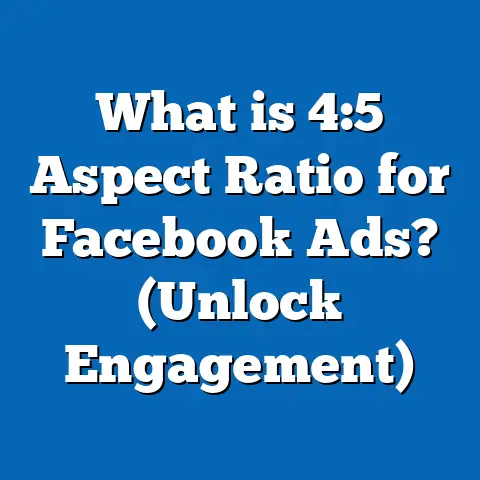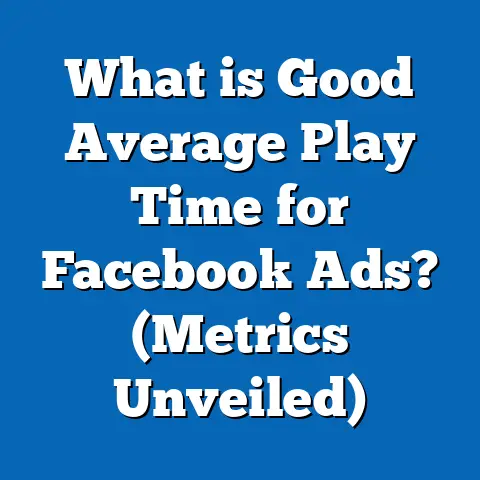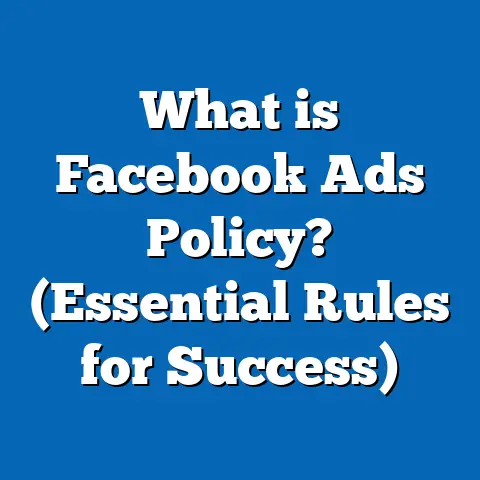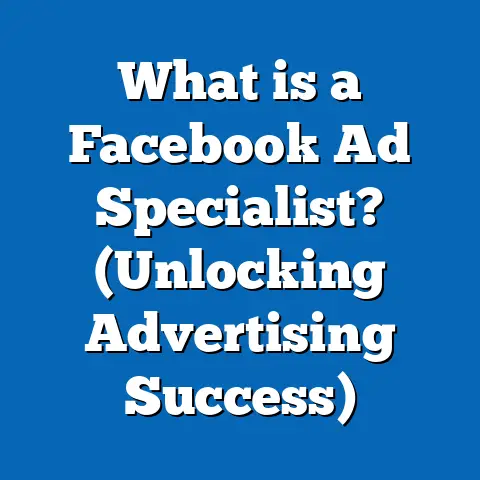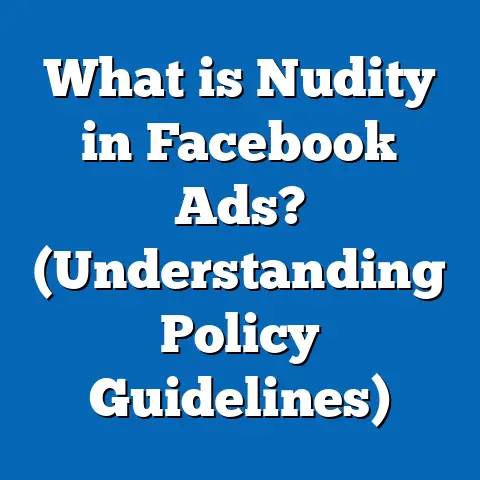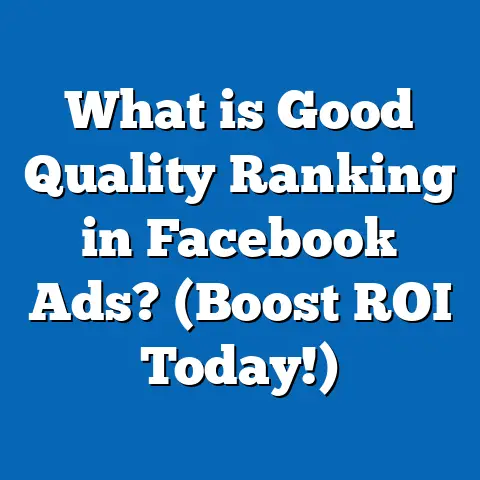What is Broad Targeting in Facebook Ads? (Unlocking Reach)
What is Broad Targeting in Facebook Ads? (Unlocking Reach)
Introduction: Remember When Marketing Was Simple?
Think back to a time when marketing was as simple as putting up a sign outside your local shop or handing out flyers in the neighborhood. You knew exactly who you wanted to reach—your local community, your regular customers. Fast forward to today’s digital age, especially on platforms like Facebook, and marketing feels both exciting and overwhelming. The tools available can pinpoint audiences with surgical precision, but sometimes, trying to zero in too tightly can limit your reach and potential growth.
Understanding Broad Targeting in Facebook Ads
What Is Broad Targeting?
Broad targeting refers to an advertising approach where you set minimal demographic or interest restrictions on your Facebook ad audience. Instead of narrowing down your audience with numerous filters, you leave the targeting wide open, allowing Facebook’s algorithm to optimize delivery to the people most likely to engage or convert.
This is the opposite of narrow targeting, which involves selecting specific age groups, locations, interests, behaviors, or other detailed criteria.
Why Does Broad Targeting Matter?
Broad targeting is important for several reasons:
- Reach and Scale: It allows advertisers to access a much larger pool of potential customers.
- Facebook’s Algorithm Strength: Facebook uses machine learning algorithms that learn who responds best to your ads and automatically optimize delivery.
- Cost Efficiency: Ads can often perform better at a lower cost per result because the algorithm tests various audience segments internally.
- Discovery: It can help brands reach new audiences they might not have considered before.
How Does Facebook’s Algorithm Work with Broad Targeting?
Facebook’s ad delivery system uses a process called machine learning to optimize your ads. When you run a broad-targeted ad:
- The system initially shows your ads to a diverse group within the broad audience.
- It collects data on who interacts positively (clicks, conversions, engagements).
- Over time, it focuses more on those who are more likely to take the desired action.
This process is known as campaign budget optimization and ad set optimization—where the platform allocates more budget to high-performing segments automatically.
How Broad Targeting Fits into Facebook’s Advertising Ecosystem
Facebook’s advertising platform offers multiple targeting options:
- Core Audiences: Based on demographics, location, interests, behaviors.
- Custom Audiences: Based on your data like customer lists or website visitors.
- Lookalike Audiences: Targets people similar to your existing customers.
Broad targeting typically refers to using Core Audiences with very minimal filters or sometimes just location and age parameters.
The Science Behind Broad Targeting: How Machine Learning Powers It
Understanding Facebook’s Learning Phase
When you launch an ad campaign with broad targeting, Facebook enters what’s called the learning phase. During this period:
- The system gathers data on how different segments of the broad audience respond.
- This phase usually requires around 50 conversions per ad set to stabilize performance.
- Once enough data is collected, the algorithm “learns” which audience segments provide the best results.
This phase is crucial for broad targeting success because the algorithm essentially discovers your most valuable customers without you needing to specify them.
Why Algorithms Outperform Manual Targeting Over Time
Manual targeting depends on assumptions about who your customers are based on demographics or interests. However:
- People’s interests are dynamic and sometimes hidden.
- Manual targeting can miss emerging segments or niche groups.
- Algorithms process millions of data points and real-time engagement signals to continuously refine targeting.
Facebook’s machine learning can identify patterns invisible to human marketers, which is why broad targeting often outperforms tightly controlled manual segmentation.
Data and Statistics Supporting Broad Targeting
Key Data Points
- According to Facebook’s internal research, advertisers using broad targeting combined with automatic placements saw a 10-30% lower cost per result compared to those who used detailed targeting.
- A study by AdEspresso found that campaigns with broader audiences had up to 25% higher reach and improved conversion rates over narrow targeting.
- Facebook reports that its machine learning systems improve over time as they gather more data, meaning broad targeting campaigns often get better results after the initial learning phase (typically 50 conversions per ad set).
- In 2023, data from WordStream showed that campaigns leveraging broad targeting had a 15% higher click-through rate (CTR) on average compared to highly segmented campaigns.
- Nielsen Catalina Solutions reported that broad targeting led to a 20% increase in incremental sales for FMCG brands advertising on Facebook.
Why These Numbers Matter
These statistics prove that:
- Broad targeting can reduce your cost per acquisition (CPA).
- It allows brands to reach more people without sacrificing relevance.
- Over time, algorithm-driven optimization can uncover new audiences that manual research might miss.
Practical Insights and Case Studies
Case Study 1: E-commerce Brand Boosts Sales by 40% with Broad Targeting
An online fashion retailer shifted from narrowly targeting women aged 25-34 interested in fashion to broad targeting all adults 18+ in the U.S. with no interest restrictions. Their campaign focused on dynamic ads showcasing best-sellers.
Results:
Case Study 2: Local Service Provider Expands Customer Base
A local home cleaning service ran two campaigns simultaneously: one with narrow targeting (age 30-50, homeowners) and another with broad targeting (all adults in their city). The broad campaign attracted younger renters and property managers as new clients.
Results:
- Broad campaign generated 35% more leads at a 15% lower cost
- Narrow campaign maintained strong conversion rates but had limited scale
Case Study 3: SaaS Company Scales User Acquisition
A software-as-a-service company targeted a broad audience across multiple industries without specifying job titles or company sizes. Using video ads demonstrating product benefits, they allowed Facebook to optimize delivery.
Results:
- User sign-ups increased by 50%
- Cost per sign-up dropped 30%
- New industry verticals emerged among users outside initial assumptions
How to Implement Broad Targeting Effectively
Step 1: Define Clear Campaign Objectives
Broad targeting works best when your campaign goal is focused and measurable—such as conversions, sales, or app installs—because Facebook needs clear signals for optimization.
Step 2: Use Campaign Budget Optimization (CBO)
Set your budget at the campaign level rather than individual ad sets. This lets Facebook distribute budget dynamically across ads and audience segments.
Step 3: Avoid Overlapping Audiences
When running multiple ad sets or campaigns, ensure audiences don’t overlap significantly. This prevents internal competition and drives clearer data signals.
Step 4: Use Creative Variations
Test different ad creatives (images, videos, copy) simultaneously. Broad targeting combined with diverse creative assets helps the algorithm identify what resonates best.
Step 5: Monitor Learning Phase Metrics
Facebook’s learning phase occurs during the first few days of an ad set. Be patient during this period and avoid making major changes until sufficient data is collected.
Step 6: Leverage Automatic Placements
Allow Facebook to place your ads across its network (Instagram, Messenger, Audience Network) automatically. Combined with broad targeting, this maximizes reach potential.
Deep Dive: Components of Broad Targeting Setup
Minimal Demographic Filters
You can start simply by selecting:
- Location: Country, region, or city
- Age range: Usually wide (e.g., 18-65+)
- Gender: Either all or specific if necessary
Avoid adding interests or behavior filters unless absolutely necessary for initial qualification.
Custom Audiences vs. Broad Targeting
Custom Audiences are based on your first-party data — website visitors, email lists, app users — while broad targeting focuses on reaching new people outside those groups.
Use Custom Audiences for retargeting warm leads and broad targeting for cold audience acquisition.
Lookalike Audiences as an Extension
Lookalike Audiences are built from your Custom Audiences and represent people similar to your best customers. They are often considered between narrow and broad targeting depending on their size (1% lookalikes are narrow; larger percentages become broader).
Common Mistakes When Using Broad Targeting & How to Avoid Them
- Changing Ads Too Quickly During Learning Phase
The learning phase requires data accumulation. Constant edits reset this phase and harm performance. Let campaigns run at least 3–5 days before making changes. - Ignoring Creative Quality
Even the best algorithms can’t save poor creative. Use high-quality images/videos with clear calls-to-action (CTAs). - Setting Unrealistic Budgets
Small budgets reduce data volume and slow learning. Allocate enough budget for Facebook to deliver at least 50 conversions per ad set quickly. - Not Testing Multiple Creatives
Relying on one creative limits optimization potential. Test different angles for message and design. - Neglecting Post-Campaign Analysis
Analyze demographic breakdowns post-campaign to discover unexpected top-performing segments for future campaigns.
Advanced Tips for Maximizing Broad Targeting Results
Leverage Lookalike Audiences with Broad Targeting
While broad targeting opens up new audiences freely, combining it with lookalike audiences based on high-value customers ensures relevance with scale.
For example:
- Start with a 1% lookalike audience for precise matching.
- Gradually expand to 5% or 10% for broader reach while maintaining similarity.
Use Detailed Targeting Expansion Feature
Facebook offers a feature called Detailed Targeting Expansion, which allows the platform to go beyond your specified interests if it predicts better results elsewhere. This feature works well when you want some guidance but still want room for discovery.
Combine Broad Targeting with Retargeting Campaigns
Create a layered funnel:
- Use broad targeting for cold traffic acquisition.
- Retarget website visitors or engagement through Custom Audiences.
- Use narrow targeting for bottom-of-funnel conversions.
This strategy balances reach with efficiency.
Test Different Campaign Objectives
Try various objectives like:
- Conversions
- Traffic
- Video views
- Lead generation
Each objective signals different user behaviors; some may work better with broad audiences depending on your product/service.
Technical Breakdown: How Facebook’s Algorithm Optimizes Ads with Broad Targeting
Facebook’s ad delivery system optimizes based on four key factors:
- Bid Strategy: Determines how aggressively you want Facebook to bid for impressions.
- Budget Allocation: How much money is spent per ad set or campaign.
- Audience Signals: Initial parameters you set plus implicit data like user behavior.
- Ad Quality & Relevance: Engagement rates influence how often your ads are shown.
With broad targeting:
- The algorithm tests different micro-segments within the wide audience.
- Adjusts bids dynamically based on predicted conversion likelihood.
- Uses real-time feedback loops to refine delivery every few hours.
Understanding these elements helps marketers trust broad targeting while providing strong creatives and budgets for performance.
Comparing Broad Targeting With Other Platforms’ Approaches
| Platform | Approach to Broad Targeting | Notes |
|---|---|---|
| Strong machine learning-driven optimization | Best-in-class algorithm; integrated placements | |
| Google Ads | Broad match keywords | Similar concept but keyword-driven |
| More manual audience creation; less automated | Narrower professional focus | |
| TikTok | Early-stage AI optimization | Rapidly improving; favors creative |
| Interest + behavior-based with some automation | Less advanced than Facebook |
Facebook remains the leader due to its vast user data and advanced AI systems enabling effective broad targeting at scale.
Latest Trends in Facebook Ad Targeting (2024)
Increased Emphasis on AI and Machine Learning
Facebook continues refining its AI models for:
- Faster learning phases
- Better prediction of user intent
- Dynamic creative optimization alongside audience optimization
Privacy Changes Affecting Targeting Precision
With stricter privacy laws (GDPR, CCPA) and iOS privacy updates limiting tracking:
- Advertisers rely more heavily on algorithmic optimization via broad targeting rather than granular manual data.
- First-party data and Custom Audiences remain important but are complemented by broader approaches.
Automation Tools & Campaign Management Enhancements
Facebook has introduced tools like:
- Automated creative testing
- Budget automation tools
- Data-driven attribution models
These tools pair well with broad targeting strategies by removing manual guesswork.
Cross-platform Reach & Unified Campaigns
Running campaigns across Facebook-owned apps (Instagram, Messenger) maximizes exposure when combined with broad targeting due to seamless audience overlap handling by Facebook’s system.
Detailed Walkthrough: Setting Up a Broad Targeting Campaign Step-by-Step
- Choose Your Campaign Objective
Pick objectives like Conversions or Traffic for best results with broad audiences. - Set Campaign Budget Optimization (CBO)
Enable CBO for automatic budget distribution across ad sets. - Create Ad Sets With Minimal Filters
- Select location(s) relevant to your business.
- Set a broad age range (e.g., 18–65+).
- Choose gender only if necessary.
- Avoid detailed interests/behaviors unless testing expansions.
- Enable Detailed Targeting Expansion (Optional)
Let Facebook broaden interest-based segments if performing well. - Select Automatic Placements
Allow ads across all Facebook platforms for maximum reach. - Design Multiple Creatives
Include carousel ads, single images/videos, and varied copy styles. - Implement Pixel or SDK Tracking
Ensure proper tracking of conversions/events for accurate algorithm feedback. - Launch & Monitor Learning Phase
Avoid edits during first few days; track key metrics daily. - Analyze Demographic Breakdown Post-Learning Phase
Identify top-performing segments for future refined campaigns or lookalike audience creation. - Scale Budgets Gradually
Increase budgets systematically once stable performance is confirmed.
Practical Example: Broad Targeting Setup for a New Product Launch
Imagine launching a new eco-friendly water bottle brand nationally:
- Objective: Conversions (Online Purchases)
- Audience: All adults aged 18–65+ in the U.S., no interests selected
- Budget: $50/day campaign budget
- Placements: Automatic across Facebook, Instagram
- Creatives:
- Video showing product features
- Carousel highlighting sustainability benefits
- Pixel Setup: Track “Purchase” event
- Monitor daily metrics; avoid edits first week
- After two weeks:
- Analyze which age groups/genders convert best
- Create lookalikes based on purchasers
- Scale up budget focusing on best-performing segments discovered from broad campaign insights
Addressing FAQs About Broad Targeting in Facebook Ads
Q1: Is broad targeting suitable for all business sizes?
Yes! Both small businesses and large brands benefit from broad targeting by unlocking new audiences beyond their assumptions.
Q2: Can I use interest-based filtering with broad targeting?
You can keep filters minimal or use the detailed targeting expansion feature for slight guidance without restricting reach too much.
Q3: How long should I wait before optimizing my campaign?
Wait until the learning phase completes—usually after about 50 conversions per ad set—before making significant changes.
Q4: Will my ad spend increase with broad targeting?
Not necessarily; broad targeting often lowers cost per result due to efficient algorithmic delivery once optimized.
Q5: How do I measure success in broad targeting campaigns?
Track conversion rates, cost per acquisition (CPA), return on ad spend (ROAS), and engagement metrics while monitoring demographic breakdowns regularly.
Summary & Next Steps
Key Takeaways:
- Broad targeting opens up large pools of potential customers by minimizing restrictive filters.
- Facebook’s machine learning optimizes delivery efficiently over time when given broad audiences.
- Data shows broad targeting often leads to lower costs and higher reach compared to narrow targeting.
- Effective implementation includes setting clear goals, using campaign budget optimization, testing creatives, and being patient during learning phases.
- Combining broad targeting with lookalike audiences and retargeting creates a balanced advertising strategy.
- Staying updated on platform changes and leveraging automation tools enhances success.
Next Steps for Marketers:
- Start small by testing a broad targeting campaign alongside your current narrow campaigns.
- Use Facebook’s reporting tools to analyze which audience segments are responding.
- Gradually increase budget based on performance while refining creative content.
- Explore lookalike audiences and detailed targeting expansion features.
- Keep up with Facebook’s updates on privacy and algorithm changes to adjust strategies accordingly.
Broad targeting is not about giving up control but about trusting smart systems while guiding them with clear objectives and creative assets. It’s a powerful way to unlock reach and find new customers in today’s complex advertising landscape.
If you want me to provide customized campaign templates or industry-specific examples leveraging broad targeting strategies next, just let me know!

